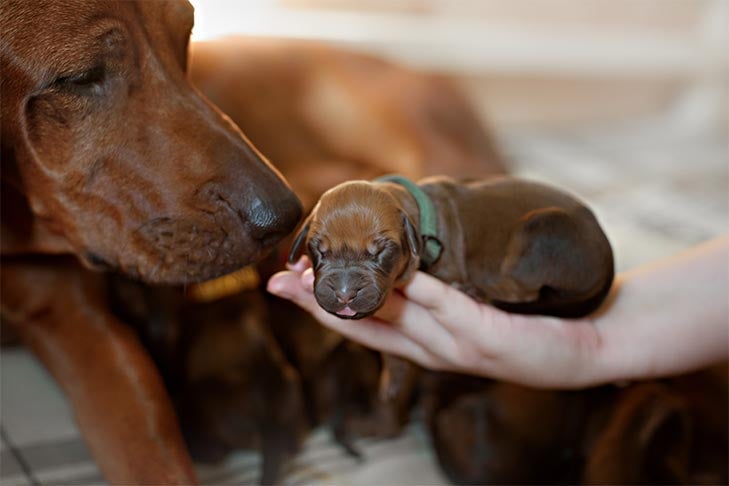Mastitis in dogs is not as common as in other species, such as cattle, but if left unchecked, the condition can lead to life-threatening consequences. To ensure the health of nursing dogs, breeders should be aware of the signs and management options.
Karen Von Dollen, DVM, of NC State College of Veterinary Medicine offers suggestions on what to look for in your bitches after whelping to catch and treat mastitis early for the quickest resolution.
What is Mastitis?
Mastitis is an infection of the mammary glands in nursing female animals. While it is more commonly a bacterial infection, fungal infections can also occur. The most frequently seen pathogens causing mastitis are Escherichia coli, Staphylococcus sp., and Streptococcus sp. Mastitis can quickly change from a mild, localized infection to an abscess in the mammary gland or a potentially deadly systemic illness.
Risk Management and Early Signs
“There are no specific husbandry practices that will prevent mastitis, but general attention to detail in the whelping area will promote the health of bitch and pups,” Von Dollen says.
All breeds of dogs, of any age, and new or experienced mothers, can be at risk of developing mastitis while nursing. The size of the litter does not affect the mother’s chances of infection, although mammary glands are more likely to become engorged in bitches with fewer puppies. With larger litters, the orifices of the teats remain open longer, allowing bacteria to more easily move into the mammary glands. Whelping boxes and puppy-raising areas should always be kept clean and dry, with soiled bedding removed as soon as possible.
Von Dollen recommends that the bitch’s mammary glands be checked once or twice daily to monitor for signs of change “as opposed to waiting until there is an obvious full-blown problem.” The glands should be gently expressed daily to monitor the quality of the milk. Changes in texture (firmness or swelling), temperature (either hot or cool), skin color (redness or a blue hue), sensitivity (your bitch’s reaction to your touch), or character of the secretions (thickness or color) should be evaluated by a veterinarian.
In mild or early cases of mastitis, the first sign of a problem may be that the nursing young are not gaining weight as quickly as expected. This is why it is important to closely monitor each puppy, including daily weigh-ins, especially in the first week of life. In these early stages, the dam may not show any overt signs of illness and may show only minimal discomfort. As mastitis progresses, the affected mammary glands become increasingly swollen and inflamed, discolored (frequently red or purple), and very painful. In severe cases, the dam can become very ill.

Diagnosis and Treatment
Your veterinarian will make a diagnosis and treatment plan based on a thorough physical exam and clinical evaluations. They will differentiate galactostasis (milk engorgement in the glands without an infection) from mastitis based on the severity of physical signs and whether there is systemic illness.
A culture and cytology of the secretions from the affected gland may be performed to look for infectious agents, such as bacteria or fungus. Ultrasounds can be useful for your veterinarian to determine the extent of damage to the gland, as well as to monitor progression and resolution of the disease. Blood work may also be done to determine if there is systemic involvement.
Your veterinarian will prescribe treatment based on the examination and test results. Most bitches with mild mastitis can be treated on an outpatient basis. Antibiotics may be prescribed, based on bacterial involvement, as well as pain medications. Nursing puppies must be considered when choosing an antibiotic because transmission to the puppies through the milk is possible. Nursing puppies should be monitored closely for changes in consumption, energy, and stool.
Other care recommended for the bitch may include hydration, warm compresses using towels or cabbage leaves, and frequent expression of milk from the infected gland by hand. This alleviates discomfort and swelling while also encouraging blood flow. Hand-milking should be performed every six hours.
The use of cabbage leaf compresses is often used to decrease pain and inflammation. Cabbage leaves should be secured to the affected mammary gland using a bandage or fitted t-shirt. Once applied, they should be left in place for two to four hours. At this time, the cabbage leaves should be removed for three to four hours before reapplying for another two to four hours. The puppies can be allowed to nurse from the affected gland when it is uncovered.
Prognosis
With early diagnosis, the mammary gland can return to normal function in about two to three weeks with appropriate treatment. In more severe cases, permanent damage may occur, rendering that gland unable to produce milk. In very severe cases where systemic infection occurs, death of the bitch is possible, even with aggressive treatment.
What About the Puppies?
Puppies are “best equipped to remove milk from the glands in an efficient manner, much more so than the human hand,” Von Dollen says. However, if the bitch is too sore to allow nursing, or if there is a concern with the antibiotics in use transferring to the puppies, nursing may not be an option. In that instance, the puppies will need to be hand-fed per your veterinarian’s instructions.
Puppies should be weighed daily to ensure early intervention if they are not receiving enough milk, either from the bitch not allowing them to nurse sufficiently or from decreased milk production. If they are not gaining weight adequately, they may need supplemental nutrition.
Final Thoughts
Early intervention is key to keeping mastitis from becoming a life-threatening illness. Regular monitoring of a nursing bitch and the puppies is crucial to ensure that the disease is caught quickly. Your veterinarian will be your best guide to keeping your bitch and pups healthy.
The post Mastitis in Nursing Mother Dogs appeared first on American Kennel Club.



0 Comments
Recommended Comments
There are no comments to display.